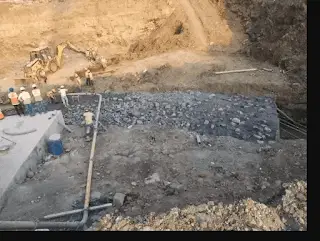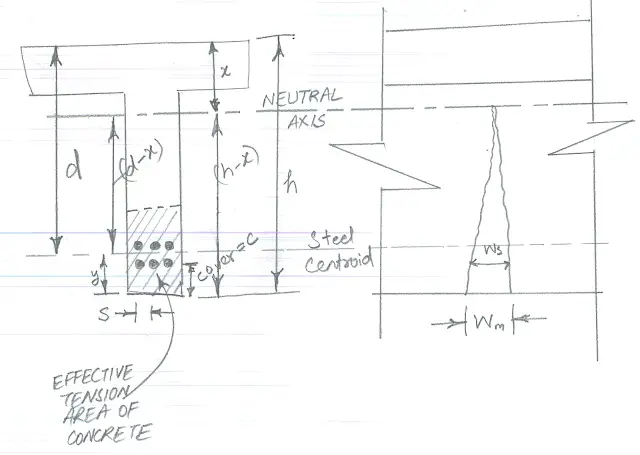The word plum means large stones which are termed as boulders or coarse aggregates if technically speaking.
The plum concrete is actually an economical variation of mass concrete. It is one of the many different types of concrete. The use of plum concrete is preferred if the required thickness of PCC is excessive or large.
This is mainly done below the foundations where due to steep slope of the strata, the quantity of leveling course could be excessive.
Content
Like Us on Facebook!
Subscribe Us on YouTube!
Definition of Plum Concrete
The plum concrete is defined as:-
A mixture of coarse aggregate and cement that are placed below the foundation or footing of a structure so as to achieve a level surface for equal distribution of load.
 |
| What is Plum Concrete? |
Application of Plum Concrete
- In one example the plum concrete can be used below footings of residential buildings having small portion where the slope of ground below single footing is 1:10 to 1:50 so to save the cost of concrete plum concrete is usually preferred. This will result in minimization of the construction cost of building as a whole.
- Plum Concrete is also used in areas that require massive concrete placements like concrete dams or bridge piers. In such cases pieces of rock about 150 mm in size are used as coarse aggregates to mix a plum concrete.
- Similarly in another example; suppose the foundation pit for a machinery bed is proposed to have a certain depth but the hard stratum is available at 3 m below the ground level. Whereas in design It was proposed that the depth of foundation for bed would be 1.5 m. Since the foundation has to be rested on the hard strata of soil, so plum concrete of lean ratio with 80mm -100mm size stones would be poured which will be rammed upto 1.5 m and thereafter regular designed raft, footings may be laid.
Mix Design of Plum Concrete
I was actually working on a building project a few years back, when I joined the project the excavation work was nearly done and my senior engineer told me that they are getting prepared for placement of plum concrete. And when I heard the word “plum concrete” I was stunned as I haven’t heard that thing in the past as I was fresh obviously :D.
But the reason of explaining above fact was that I had actually worked on the project where we placed plum concrete. So for that particular project we used 40% boulders and 60% concrete which means M15 was used.
Construction Methodology of Plum Concrete
Step 1 – Transportation of Plum Material
The boulders are large Stone size which can be lifted by laborers easily, not too big or small.
Step 2 – Leveling and Cleaning – Surface Preparation
The first step that is done initially is leveling and cleaning of the surface by removal of soft soil that can cause low bearing capacity. After clearing and grubbing water is sprayed to the surface to make it wet before placement of plum concrete. The reason of sprinkling water is to ensure proper bond of plum concrete with the ground surface. After sprinkling of water anti-termite chemical is sprayed which is essential now a days for the flawless foundation of a structure.
Step 3 – Pacing and Spreading of Plum Concrete
Boulder\’s are spread over the ground with little gapping layer by layer and concrete is spread using pump all over the boulder\’s in each layer which slowly permeate inside the gapping between boulder’s. This helps to bind it properly, after pouring concrete, boulders are thrown into the concrete again and the process repeats till required level surface is reached.
Step 4 – Curing of Plum Concrete
Curing should be done for next 7 days minimum. Jute bags are spread over the whole area of plum concrete to retain moisture for a long time after curing.
Boulder\’s should be inspected before spreading and if any dirt or Clay is found, then it should be washed properly.
Boulder\’s should be strong and should not be falky. since, whole building load is going to act upon it.
Fact is that nobody in construction site, measures that how much boulder\’s and concrete is used in doing plum concrete. Sometimes, more boulder\’s are needed when there is dearth of concrete or for economical purpose etc.
Specifications for plum Concrete
- Plum shall comprise of black trap basalt of crushing strength of minimum 100 Kg /Sqcm.
- The concrete shall be of nominal mix 1:4:8 using aggregate of maximum size 25mm.
- The volume of the plum in the concrete shall not exceed 50% of total volume.
- The crevices shall not be less than 150 mm.
- Layer shall not exceed 900mm.
The nominal maximum size of coarse aggregate should be as large as possible within the limits specified but in no case greater than one-fourth of the minimum thickness of the member, provided that the concrete can be placed without difficulty so as to surround all reinforcement thoroughly and fill the comers of the form.
As for the requirement of the aggregate size that can be used in the plum concrete there are different recommendations by the IS code; the code says that for most of the common works the size of 20 mm aggregate is suitable and best. If there are no restrictions for flow of concrete into section 40 mm or larger can also be used. But where there are reinforcement or the cover is small with the formwork 10 mm nominal maximum size of plums should be used in plum concrete.
Plums above 160 mm and up to any reasonable size may be used in plain concrete work up to a maximum limit of 20 percent by volume of concrete when specifically permitted by the engineer-in-charge.
However for all the cases, the plums shall be distributed evenly and shall not be closer than 150 mm from the surface.
Difference between Plum Concrete and Mass Concrete
Sometimes the people do have misunderstanding about the difference between plum concrete and the mass concrete. The both are actually one and the other thing; mass concrete is a term used for concrete that is placed in large size and huge quantity that can either be a plain concrete or reinforced according to the requirements of the structure or project. The term mass concrete is just used to define the massiveness in quantity.
But as for the plum concrete it is by all means plain having large size of aggregates, as explained above called plums and they can be used with different grades of concrete.
What’s further…???
So in this post you have completely learnt about what is plum concrete, what is the use and advantages of plum concrete, what is the mix design and what are the different specifications or guidelines for the plum concrete.
If you think I have missed anything that you know must be added than please do comment your thoughts below.





















